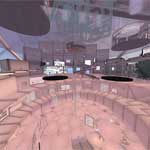It may surprise you to learn that online education, or materials presented over the Internet to provide instruction on any given subject, was used by students before home computers became popular. University of Illinois scientists created a classroom system based in linked computer terminals in the 1960s. While this first online learning experience — now also called E-learning — did not match the Web learning offered today, it was a landmark experience in online education.
Before that time, distance learning was employed by organizations and individuals through mail and even by telegraph. The following Web sites, resources, articles, journals, organizational histories and abstracts offer insights into the development of online education and how this form of learning has progressed, including forecasts about how online learning may proceed into the future.
Articles
 A Brief History of Online Education: This short article looks at the beginnings of online education from the corporate angle in the 1980s. The author offers a brief introduction to CALCampus, a distance-learning organization that introduced the first entirely online curriculum.
A Brief History of Online Education: This short article looks at the beginnings of online education from the corporate angle in the 1980s. The author offers a brief introduction to CALCampus, a distance-learning organization that introduced the first entirely online curriculum.- History of Online/Distance Public Education in America: This article by AdultLearn is a bit more comprehensive about the progress of distance education.
- History of Online Education: This article is a short overview of online education history.
- Industry Report – Introduction: This is the introduction to a four-part article on the history of online education. The articles discuss online education history as well as issues and possible future of this educational format.
- Online Adult Education: A Look Back to the Future: This brief history of online education breaks the history timeline down into earmarked years that saw vast improvements.
- Online Education Overcoming Its Origins: This article focuses on the reputation earned through correspondence courses and how online education is overcoming that stigma.
- The History of Distance Education: Michael Jeffries, assistant director of educational services IHETS, offers an article that looks at virtual education that dates back to the 1700s.
- The History of Higher Education in the United States: This World Wide Learn article approaches online education with a short history about higher education in the U.S.
- The Origins of Distance Education and its use in the United States: This journal article explains the difference between distance education, which can include hard-copy correspondence, and online education, which is conducted entirely through the Internet.
- What Is the History of Online Education? Another very short summary of online education beginning in 2000.
Timelines & Infographics
 Distance Education Timeline: This timeline, based upon virtual rather than just computer, learning begins in 2840 with Isaac Pitman, who taught shorthand by correspondence.
Distance Education Timeline: This timeline, based upon virtual rather than just computer, learning begins in 2840 with Isaac Pitman, who taught shorthand by correspondence.- Online Learning Timeline: This timeline begins with PLATO (Programmed Logic for Automatic Teaching Operations), which was the first computer assisted instruction system.
- Pearson Timeline: This leading educational and professional publisher dates back to 1725. Recently, they opened the Pearson iDEA Innovation Center, a digital laboratory focused on user-centered design, software usability testing, and efficacy research.
- The History of Online Education: This information graphic begins with the 1960s and offers a timeline as well as other graphically-illustrated information.
- Video Game Timeline: If you do any learning through virtual worlds, this video game timeline may interest you…it begins in 1972 with the world’s first home video game console, the Magnavox Odyssey.
Web Sites and Abstracts
- CALCampus: This is the home of the organization that introduced the first entirely online curriculum. CALCampus remains an accredited online distance learning school, located in the U.S., offering college and high school course instruction through the Internet. They also maintain a page filled with articles about the history of online learning.
- Education Program for Gifted Youth: This Stanford University program offers one of the most historic online education courses, as it has offered individual online courses since 1990 and a summer program since 2000 to gifted youth in high school.
- ERIC–The First 15 Years. A History of the Educational Resources Information Center: This link leads to an article and abstract concerning this organization’s programs, organization and first 15-year history. ERIC is a federally-funded nationwide information system established to provide easy access to information about education research, including online education courses and programs.
- Online Distance Education: Historical Perspective and Practical Application [PDF]: This 1997 report is an abstract of a dissertation submitted to American Coastline University Graduate School of Community and Human Services for partial fulfillment of the requirements for a doctoral degree in distance education and technology.
 PLATO History: This is the home of the PLATO (Programmed Logic for Automatic Teaching Operations) History Foundation and the archive for information about the history and significance of the PLATO computer system and its online community.
PLATO History: This is the home of the PLATO (Programmed Logic for Automatic Teaching Operations) History Foundation and the archive for information about the history and significance of the PLATO computer system and its online community.- The Virtual University Becomes a Reality [PDF Download]: This paper offers background and history on the MIT OpenCourware Web-based electronic publishing initiative, with goals to provide free, searchable and coherent access to virtually all MIT course materials for educators, students, and individual learners around the world. MIT made their announcement about this project in April 2001.
- Visions Shaping the Future of Online Education: Understanding its Historical Evolution, Implications, and Assumptions: The purpose of this paper, written by Dr. Jorge Gaytan, was to present a historical background of online education, review its current status, and provide visions shaping its future in an attempt to understand its potential and limitations that will lead to the advancement of the scholarship of teaching and learning.
Organizations and Journals
- Association for Educational Communications and Technology: AECT is a professional association of thousands of educators and others whose activities are directed towards improving instruction through technology. This site contains information about the organization’s history, its past presidents and history.
- Educause: This is a nonprofit association whose mission is to advance higher education by promoting the intelligent use of information technology. Their press releases date back to 2000, providing ample information about this organization’s role in online education.
- eSchool News Archives: The news archives from January 1998 to the present are available for this publication that covers education technology in all its aspects — from legislation and litigation, to case studies, to purchasing practices and new products.
- Tech & Learning: This link leads to an article that celebrates 30 years for this journal. The article contains links to some of the most influential individuals — movers and shakers — within the online education industry.
- The Adult Education History Project: In 1986, the Adult Education Graduate Program, Syracuse University, began the Syracuse University Kellogg Project. It was designed to “tap the potential” of a large university library archival collection, the world’s largest compilation of English-language materials on adult education.
- The eLearning Guild: The eLearning Guild is the oldest and most trusted source of information, networking, and community for e-Learning Professionals. This link leads to information about this organization, its history and its interaction with online educational processes.
- The History of iNACOL: The International Association for K-12 Online Learning, is a non-profit organization that facilitates collaboration, advocacy, and research to enhance quality K-12 online teaching and learning. This link leads to a history about this organization and its role in online education.
- World Association for Online Education (WAOE) academic NPO: This link leads to resources that hold WAOE electronic bulletin archives, direct access to the Journal of Online Education, a link to history and multicultural activities since mid-2007 and an inventory of WAOE commissioned sites as of 2010.
